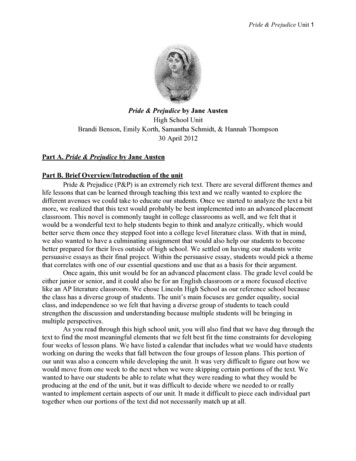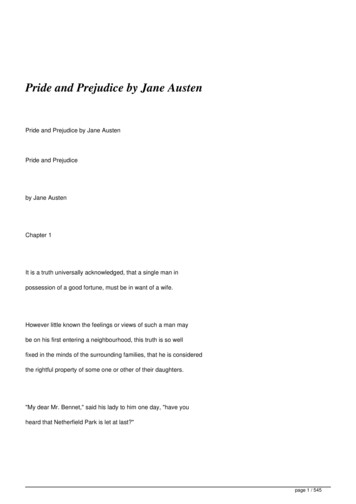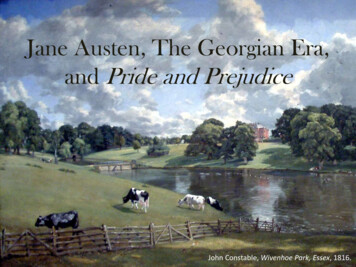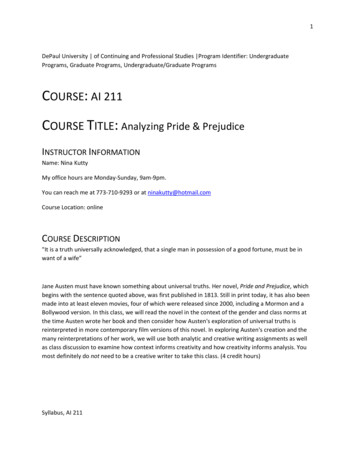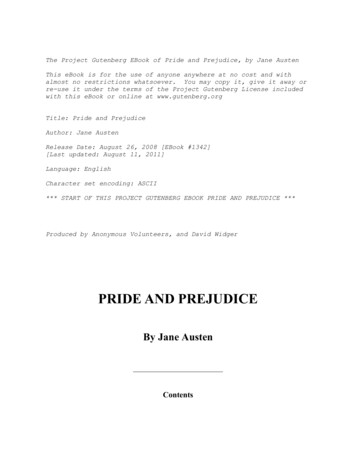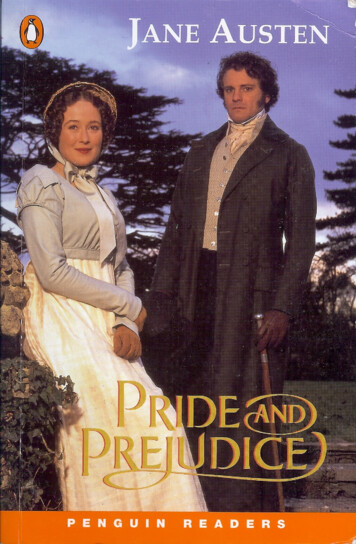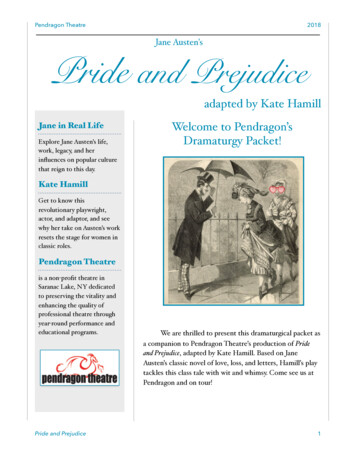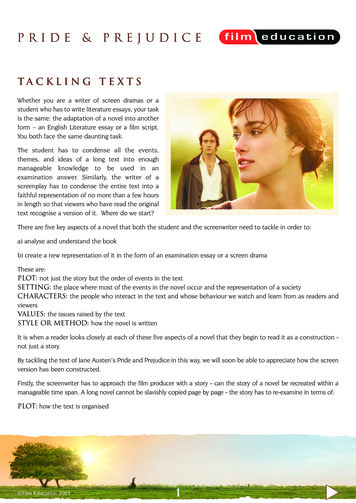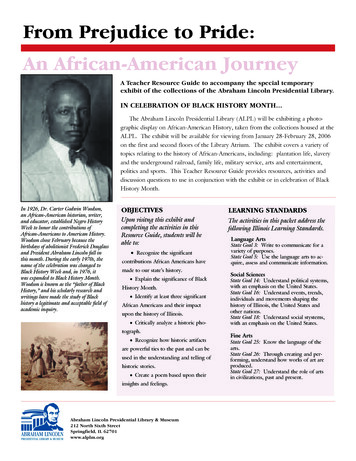
Transcription
From Prejudice to Pride:An African-American JourneyA Teacher Resource Guide to accompany the special temporaryexhibit of the collections of the Abraham Lincoln Presidential Library.IN CELEBRATION OF BLACK HISTORY MONTH.The Abraham Lincoln Presidential Library (ALPL) will be exhibiting a photographic display on African-American History, taken from the collections housed at theALPL. The exhibit will be available for viewing from January 28-February 28, 2006on the first and second floors of the Library Atrium. The exhibit covers a variety oftopics relating to the history of African-Americans, including: plantation life, slaveryand the underground railroad, family life, military service, arts and entertainment,politics and sports. This Teacher Resource Guide provides resources, activities anddiscussion questions to use in conjunction with the exhibit or in celebration of BlackHistory Month.In 1926, Dr. Carter Godwin Woodson,an African-American historian, writer,and educator, established Negro HistoryWeek to honor the contributions ofAfrican-Americans to American History.Woodson chose February because thebirthdays of abolitionist Frederick Douglassand President Abraham Lincoln fall inthis month. During the early 1970s, thename of the celebration was changed toBlack History Week and, in 1976, itwas expanded to Black History Month.Woodson is known as the “father of BlackHistory,” and his scholarly research andwritings have made the study of Blackhistory a legitimate and acceptable field ofacademic inquiry.OBJECTIVESLEARNING STANDARDSUpon visitng this exhibit andcompleting the activities in thisResource Guide, students will beable to:The activities in this packet address thefollowing Illinois Learning Standards. Recognize the significantcontributions African Americans havemade to our state’s history. Explain the significance of BlackHistory Month. Identify at least three significantAfrican Americans and their impactupon the history of Illinois. Critically analyze a historic photograph. Recognize how historic artifactsare powerful ties to the past and can beused in the understanding and telling ofhistoric stories. Create a poem based upon theirinsights and feelings.Abraham Lincoln Presidential Library & Museum212 North Sixth StreetSpringfield, IL 62701www.alplm.orgLanguage ArtsState Goal 3: Write to communicate for avariety of purposes.State Goal 5: Use the language arts to acquire, assess and communicate information.Social SciencesState Goal 14: Understand political systems,with an emphasis on the United States.State Goal 16: Understand events, trends,individuals and movements shaping thehistory of Illinois, the United States andother nations.State Goal 18: Understand social stystems,with an emphasis on the United States.Fine ArtsState Goal 25: Know the language of thearts.State Goal 26: Through creating and performing, understand how works of art areproduced.State Goal 27: Understand the role of artsin civilizations, past and present.
Illinois History MakersThroughout Illinois' long history, African-Americans have made significant contributions in all areasof our social, political, cultural and economic past. A few of those individuals are highlighted here;more are featured in the ALPL exhibit From Prejudice to Pride: An African-American Journey. Theirstories are an inspiration and an integral part of our shared history.PoliticsROLAND BURRISRoland Burris was born in Centralia, Illinois. He graduated from Southern Illinois University in Carbondalewith a degree in political science in1959 and then studied at the Universityof Hamburg inGermanyfor ayear. Heearnedhis lawdegree atHowardUniversityin 1963. In 1963, Burris’s careerbegan with a position as a nationalbank examiner for the U. S. TreasuryDepartment. He was the first AfricanAmerican to be a bank examiner in theUnited States. From 1964 to 1973he was vice President of ContinentalIllinois National Bank in Chicago. Asa member of Illinois Governor DanWalker’s cabinet, he served as Directorof the Department of General Services in 1973. He was elected as statecomptroller in 1978 and served threeterms. Again he made history, this timeas the first African-American elected tostate office. In 1990, he was electedattorney general for the state of Illinoisand served from 1991 to 1995. He ranfor Governor of Illinois three times, butwas unsuccessful in his bids. Since leaving public office, he now works as anattorney with the law firm, Buford and2Peters LLC in Chicago. He specializesin environmental, consumer affairs, andestate law. He was managing partnerof the Chicago-based law firm of Jones,Ware & Grenard, one of the largestminority law firms in the country priorto his move to Buford and Peters.HAROLD WASHINGTONHarold Washington was the first African-American mayor of Chicago. Hismany accomplishments included: Creating the Ethics Commission Issuing an Executive Order increasing minority business contracts Opening government with a Freedom of Information Executive Order Leading the fight for Ward redistricting to provide more Black and Hispanicrepresentation Fighting for equal provision of public services; neighborhood street, curband gutter repair Encouraging neighborhood festivalsand projects Leading the movement for Illinois’Dr. Martin Luther King, Jr. Holidaybill.The youngest of four children,Washington was born at Cook CountyHospital in Chicago on April 15, 1922.He attended schools in Chicago, butdid not receive a high school diplomauntil after his military service. He wasdecorated for bravery for his service inWorld War II. Washington graduatedfrom Roosevelt College (now RooseveltUniversity) in 1949 and earned his lawdegree in 1952 from Northeastern University in Evanston.In 1942, Washington married Nancy Dorothy Finch. The couple had nochildren and later divorced. At the timeof his death in 1987, he was engaged toMary Ella Smith.Washington’s long career began in1952 as an Assistant City Prosecutor.In 1965 he was elected as an IllinoisState Representative for the 26th Districtand served until 1976. He moved onto the Illinois Senate, serving there from1977 to 1980. He ran for ChicagoMayor in 1977 but received only 11%of the vote. He then ran for Congressin the 1st District and served from 1981to 1983. In 1983, Washington won theDemocratic primary, prevailing over theincumbent mayor, Jane Byrne. He wonthe general election and was inaugurated at Navy Pier on April 29, 1983. Hewas reelected in 1987.On November 25, 1987, HaroldWashington died of a heart attack at hisdesk in his Chicago office. Thousandsof Chicago residents attended his wakein the lobby of City Hall. He is buriedin Oak Woods Cemetery in Chicago.The Chicago Public Library systemnamedtheirnewcentralbranchbuilding forMayorWashington,andthe Loop College, located in downtownChicago, was renamed Harold Washington College as a memorial to him.
Arts & EntertainmentGWENDOLYN BROOKSGwendolyn Brooks was born onJune 7, 1917 in Topeka, Kansas. Shemoved to Chicago as a child and stayedthere until her death on December 3,2000. Her fame was primarily for herpoetry, but she also wrote a novel, anautobiography, andother worksof prose. Herpoetry wasfirst publishedin 1945 andin 1949,her book ofpoetry, AnnieAllen, won aPulitzer Prize,the first won by an African-Americanwoman.Her poetry was based on the poorand the people of the South Side ofChicago. She began her work as acolumnist for an African-Americannewspaper, the Chicago Defender. Thestyle of her poems went from traditionalballads to sonnets to using blues andrhythms in free verse. One of her mostfamous poems, “We Real Cool,” whichis considered more “blues and rhythms,”is used in many school textbooks. Shewas considered by many as a leadingartist in the Black Arts movement.According to editor, Elizabeth Alexander of the American Poets Project,“she is nothing short of a technicalvirtuoso. That technical virtuosity wasmatched by a restless curiosity about lifeall around her in all its explosive variety.By turns compassionate, angry, satiric,and psychologically penetrating, Gwendolyn Brooks’ poetry retains its powerto move and surprise.”In 1962 she was invited to aLibrary of Congress poetry festival byPresident John F. Kennedy. She taughtat many colleges, including ColumbiaCollege Chicago, Northeastern IllinoisUniversity, Elmhurst College, ColumbiaUniversity, Clay College of New Yorkand the University of Wisconsin.She was named Poet Laureate of Illinois in 1968. She received many otherawards, including the Frost Medal, theShelley Memorial Award, an AmericanAcademy of Arts and Letters Award,a National Endowment for the Artsaward, fellowships from the Academyof American Poets and the GuggenheimFoundation, and from 1985 to 1986,she was a Consultant in Poetry to theLibrary of Congress.The Illinois State Library in Springfield was renamed the GwendolynBrooks Building in 2003.ETTA MOTEN BARNETTEtta Moten Barnett was born inTexas on November 5, 1901. Shemarried in the 1920’s but was laterdivorced. She and her three daughtersmoved in with her parents in Kansas soshe could attend college at the University of Kansas where she majored invoice and drama. A recital performanceher senior year earned her an invitationto join the celebrated Eva Jessy Choirin NewYork,which shedid upongraduation.Shebecamesuccessful in the theater and performedin many legendary Broadway productions. She broke the stereo-typicalportrayal of African-Americans withher role of a widowed housewife in theGolddiggers (1933). The performanceearned her the title of “The New NegroWoman” by the African-Americanpress. As her fame grew, President andMrs. Roosevelt invited her to sing at theWhite House in 1933.It is said that that George Gershwin thought of Etta as he wrote thecharacter of “Bess” in Porgy and Bessand wanted her to star in the play in1935. She declined the role becauseshe sang contralto and the role was fora soprano. She relented, taking the rolein 1942 for which she became famous.She went on to perform at many international concerts and music festivals,and her last performance was at a Danish concert in 1952.In 1933, she married Claude Barnett, founder of the Associated NegroPress. They were married for 33 yearsand traveled extensively in the 1950’sas members of the U.S. delegation toGhana, where in 1957, she intervieweda young Martin Luther King, Jr. on theoccasion of Ghana’s independence fromGreat Britain. She served as a delegatefor the U.S. at other ceremonies of independence for the countries of Nigeria,Zambia, and Lusaka.She received many accolades including honorary degrees from SpelmanCollege, Lincoln University, and theUniversity of Illinois. Other honorsincluded for Contributions to American Music by Atlanta University and ascholarship in her name for minoritystudents at the Chicago Academy forthe Performing Arts. Etta Moten Barnett lived in Chicago until her death onJanuary 3, 2004.3
KATHERINE DUNHAMKatherine Dunham was born in1909. She grew up in Chicago whereshe was influenced at an early age byher proximity tothe theaterand entertainment.Her desireto danceand perform beganearly,howeverher familyurged herto seek a career in teaching rather thandancing. Although she stayed with herdance studies, she majored in anthropology at the University of Chicago. As aresult of her education in anthropology,and interest in dance, she searched fora way to combine the two fields. Atthe same time, she founded a companycalled, “Ballet Negre and the NegroDance Group.” She eventually completed a Ph.D. in anthropology and danceat the University of Chicago.Dunham explored the ritual dances,music, and rhythm of the drums inJamaican culture. She changed American dance by incorporating African andCaribbean elements into her choreography. With her use of the culture,geography, community, and rhythm aspart of the dance, she established herselfas one of the creators of dance as part ofanthropology.She appeared in seven films andchoreographed many more. She leftHollywood to establish the KatherineDunham Dance Company, where blackdancers could emphasize their ownculture through dance.In 1965 she was named advisorto the cultural ministry of Senegal and4returned to the United States in 1967.She changed her focus again and movedto East St. Louis, Illinois to become anartist-in-residence at Southern IllinoisUniversity in Edwardsville. She begana decade of work with neighborhoodand youth groups focusing on turning “hostility and anger into dance andexpression.” Among her many honorsshe has received are the Kennedy CenterHonors in 1983, the Scripps AmericanDance Festival Award in 1986, theDance Magazine Award, the plaqued’Honneur Haitian-American Chamberof Commerce Award, and the SIUDistinguished Service Award and herinduction into the Black FilmmakersHall of Fame. The theater and artsbuilding at Southern Illinois UniversityEdwardsville has been named DunhamHall in her honor.SportsISIAH THOMASBorn in Chicago in 1961, IsiahThomas made a name for himself asa basketball player. Growing up inIllinois,he playedfor St.Joseph(Westchester)HighSchool.He thenplayed atIndianaUniversity. Drafted in 1981 by the DetroitPistons, Thomas eventually played in979 pro games. He helped Detroitwin back-to-back NBA Championships. Individual honors include theNaismith Memorial Basketball Hallof Fame, twelve-time NBA All Star,Walter Kennedy Citizenship Award,and one of the fifty Greastest Players inNBA History. He is still active in professional basketball in managerial roles.JESSE OWENSJesse Owens was one of thegreatest track-and-field athletes of alltime. Born in 1913 in Alabama, hewas the son of a sharecropper and thegrandson of a slave. Owens begancompeting at Ohio State, where heestablished a world record in therunning broad jump and in the 100meter dash. He gained his greatestfame at theOlympicGamesin Berlinwhere hewon fourgold medals in the100- and200-meter,the runningbroad jump, and as a member of thefour hundred meter relay team. Ineach event he either set a world orOlympic record. His success helpedcounter Adolph Hitler's German supremacy theory of the "Master Race."Later, Owens played an activerole in youth athletic programs andran his own public relations firm.Relocating to Chicago, he worked asa board member and director of theChicago Boys’ Club. In addition, heserved as the Sports Specialist of theState of Illinois Youth Commission.In 1976, President Ford presentedOwens with the nation's highest civilian honor, the Medal of Freedom.Owens died in 1980.
Medicineprocedures became standard for internal surgeries.DR. DANIEL HALE WILLIAMSArmedServicesDaniel Hale Williams was born onJanuary 18, 1856 in Hollidaysburg,Pennsylvania. In 1880, he enteredwhat is now known as NorthwesternUniELLSWORTH DANSBYversityEllsworth Dansby, of Decatur,MedicalIllinois, was always interesting in flySchool.ing. He read everything about flying,Uponand as a child, he threw himself fromgraduaa steep hill on a frame made withtion, hebedsheets. When he was 12, he flewopenedalone at an airstrip while his parentshis ownwere gone. Throughout high school,medicalDansby won trophies for his designoffice inand construction of aircraft andChicago,power structures.Illinois. Williams quickly gained aDansby wanted to enroll inreputation for professionalism andfurther training after high school, butwas appointed as a surgeon on thehis entrance was prohibited to any airstaff of the South Side Dispensary andschools because he was black. Howthen a clinical instructor in anatomyever, in 1941 he was able to enlistat Northwestern. In 1889 he was apunder a new U.S. Army Air Corpspointed to the Illinois State Board ofHealth.On January 23, 1891Daniel Hale Williams established the Provident Hospitaland Training School AssociaLOUIS ARMSTRONGtion, an interracial hospitalmeant to serve members ofALBERTA HUNTERthe community as a whole.The school also trained BlackLORRAINE HANSBERRYnurses and utilized doctors ofall races.MAHALIA JACKSONWilliams is also knownas the first American toJOE LOUISperform open heart surgerywhen, in 1893, he openedJERSEY JOE WALCOTTthe chest of a stab woundvictim and sutured his periSUGAR RAY ROBINSONcardium (the sac surrounding the heart). The patientrecovered completely and Williams’program and was the second blackperson in the nation to be allowedentry to the Air Corps. He began asa technical school instructor and afterWorld War II started, he was promoted to flight status.During World War II, Dansbybecame the first African-Americanmaster sergeant and one of the“Tuskegee Airmen,” the nation’s firstblack military fighter pilots. Later, hewas named to the Decatur Board ofEducation and the Board of Directorsof the Decatur/Macon County Opportunities Corporation. EllsworthDansby died in 1989.More History MakersERNIE BANKSLENNY MOOREJOSHUA JOHNSONBOB LOVEOTIS B. DUNCANWES HAMILTON5
Discussion QuestionsThe following questions can be used before, during or after your tour of the ALPL exhibit From Prejudice to Pride: An African-American Journey.1. Visit the exhibit From Prejudice to Pride. How is the title of the exhibit reflected in thephotographs on display? Use examples from the exhibit to support your answer.2. Choose three individuals featured in the exhibit From Prejudice to Pride. Write an essayon the importance of these individuals to African-American history.3. Identify an African-American prominent in today’s society (Jesse White, Barack Obama,Oprah Winfrey are a few examples). Write an essay on his/her life, career, achievementsand significance.4. How might the individuals in this exhibit have paved the way for today’s influentialAfrican-Americans? Name specific individuals or events in your answer.ActivitiesThe following activities can be used before, during or after your tour of the ALPL exhibit From Prejudice to Pride: An African-American Journey.1. Use the Photograph Analysis Sheet in this packet to analyze photographs in the exhibitFrom Prejudice to Pride.2. Create a class binder on Illinois’ African-American History Makers. Have each studentchoose an individual featured in the exhibit and write a biographical essay about their life.Find pictures or quotes, or create a drawing of or about that person to make the essayscolorful and eye catching. Gather your class essays together in a binder for your classroom.3. Watch clips from movies featuring African-American actors over several decades. How areAfrican-Americans portrayedin films? Has their portrayalchanged over time?4. Create a mural or collagedepicting famous AfricanAmericans and their role inIllinois History.5. Create a “Today in AfricanAmerican History .”calendar. Research importantdates in African-Americanhistory and record them on acalendar for your classroom.6. Create a trivia quiz for yourclassmates from the AfricanAmerican Chronology htm.7. Organize a Black History Month event at your school.6
Analyze a PhotographThe exhibit From Prejudice to Pride: An African-American Journey utilizes photographs from the collections of the AbrahamLincoln Presidential Library. To fully understand the exhibit, it is important to know how to "read" a historic photograph. Inthis activity, use your powers of observation and interpretation to examine a photograph from the exhibit.ObservationNameStudy the photograph carefully. Fill in the chart with the appropriate informationPeopleObjectsActivitiesWhat is the subject of this photograph?InferenceBased on what you have observed above, list three things you might infer from this photograph.1.2.3.KnowledgeWhy is this photograph important to history?What do you know about this time period or event?QuestionsWhat questions does this photograph raise in your mind?What resources would you use to find the answers to them?ActivitiesWrite a diary or journal entry or write a newspaper article as a companion to the photograph.Bring a photograph to class and ask your classmates to analyze it. What does it reveal about you and yourfamily history?7
From Prejudice to Pride:An African-American JourneyPoetry in the ExhibitMATERIALSWe Real Coolby Gwendolyn BrooksThe Pool PlayersSeven at the Golden ShovelWe real cool. WeLeft school. We 15-20 index cards per group Marker or pen PaperPROCEDURE Divide students into groups of four or five. Visit the exhibit From Prejudice to Pride: An African-American JourJourney. Identify one student to be the recorder. This student will carry theindex cards. As the group views the exhibit, ask them to identify words that describe the exhibit or their feelings upon viewing the exhibit. Be sure tochoose nouns, adverbs and adjectives. The recorder will write each wordon one index card. Once the group has come up with approximately twenty words, havethe students lay the cards out on the floor and arrange them to create afree-form poem. They do not need to use all the words. When the group is satisfied with their poem, ask them to copy it ontopaper and read it aloud for the rest of the class.Lurk late. WeStrike straight. WeSing sin. WeThin gin. WeJazz June. WeDie soon.Online ResourcesAbraham Lincoln Presidential Library and Museumhttp://www.alplm.orgAfrican-American ideAfAm.htmAfrican-Americans in t.htmAbraham Lincoln Presidential Library & Museum212 North Sixth StreetSpringfield, IL 62701www.alplm.org
From Prejudice to Pride: An African-American Journey Abraham Lincoln Presidential Library & Museum 212 North Sixth Street Springfield, IL 62701 www.alplm.org In 1926, Dr. Carter Godwin Woodson, an African-American historian, writer, and educator, established Negro History Week to honor the contributions of African-Americans to American History.
